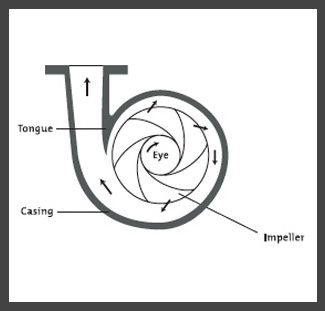Difference between revisions of "Centrifugal pump"
(Created page with "Centrifugal pump. <br> Photo: WHO. The essential components of a centrifugal pump are the fast-rotating impeller and the casing. ...") |
|||
| Line 7: | Line 7: | ||
==Suitable conditions== | ==Suitable conditions== | ||
One limitation of a centrifugal pump is that the suction height cannot be higher than about 7 m above the water level. To overcome this limitation, and make it possible to place the pump above the suction limit, some pumps inject a jet stream of water into the suction pipe inlet. The kinetic energy of the injected water is partly converted into extra pressure, which helps to lift the water above the suction limit of the pump. | One limitation of a centrifugal pump is that the suction height cannot be higher than about 7 m above the water level. To overcome this limitation, and make it possible to place the pump above the suction limit, some pumps inject a jet stream of water into the suction pipe inlet. The kinetic energy of the injected water is partly converted into extra pressure, which helps to lift the water above the suction limit of the pump. | ||
| + | |||
| + | ==Construction, operations and maintenance== | ||
| + | '''Head range''': Typically, 4–50 m per stage, with multiple-stage pumps to 200 m and more. | ||
| + | '''Yield''': Varies widely, according to many options available in the market. | ||
| + | '''Area of use''': Anywhere engine power is available. | ||
| + | '''Trademarks''': Grundfos; Drysale; Sta-rite; and others. | ||
| + | |||
| + | ==Costs== | ||
| + | Highly dependent on the power rating and quality of the pump. | ||
| + | |||
| + | ==Field experiences== | ||
| + | |||
| + | ==Reference manuals, videos, and links== | ||
| + | |||
| + | ==Acknowledgements== | ||
| + | * Brikke, François, and Bredero, Maarten. [http://www.google.com/url?sa=t&rct=j&q=&esrc=s&source=web&cd=2&ved=0CC0QFjAB&url=http%3A%2F%2Fwww.who.int%2Fwater_sanitation_health%2Fhygiene%2Fom%2Flinkingintro.pdf&ei=cwJpT-zaO-OiiQKCst2rBw&usg=AFQjCNEWOQhTgF3a7lzhuw5OA2KmbVGxcA&sig2=Rt2EURUyGVqDcwFg6p0xAw Linking technology choice with operation and maintenance in the context of community water supply and sanitation: A reference document for planners and project staff]. World Health Organization and IRC Water and Sanitation Centre. Geneva, Switzerland 2003. | ||
Revision as of 00:22, 9 May 2012
The essential components of a centrifugal pump are the fast-rotating impeller and the casing. Water flows into the centre “eye” of the impeller, where centrifugal force pushes the water outwards, to the casing. The kinetic energy of the water is partly converted to useful pressure that forces the water into the delivery pipe. Water leaving the central eye of the impeller creates a suction, which draws water from the source into the pump. An impeller and the matching section of the casing is called a “stage”.
Several stages can be combined with a single shaft to increase the overall pressure (multiple-stage pump). The water passes through the successive stages, with an increase in pressure at each stage. Multiple-stage centrifugal pumps are normally used when water has to be pumped to a significant height (200 m or more). For deep-well applications, the centrifugal pump and electrical engine are housed in a single unit. When the unit is to be located under the water level, a submersible pump will be required.
Contents
Suitable conditions
One limitation of a centrifugal pump is that the suction height cannot be higher than about 7 m above the water level. To overcome this limitation, and make it possible to place the pump above the suction limit, some pumps inject a jet stream of water into the suction pipe inlet. The kinetic energy of the injected water is partly converted into extra pressure, which helps to lift the water above the suction limit of the pump.
Construction, operations and maintenance
Head range: Typically, 4–50 m per stage, with multiple-stage pumps to 200 m and more. Yield: Varies widely, according to many options available in the market. Area of use: Anywhere engine power is available. Trademarks: Grundfos; Drysale; Sta-rite; and others.
Costs
Highly dependent on the power rating and quality of the pump.
Field experiences
Reference manuals, videos, and links
Acknowledgements
- Brikke, François, and Bredero, Maarten. Linking technology choice with operation and maintenance in the context of community water supply and sanitation: A reference document for planners and project staff. World Health Organization and IRC Water and Sanitation Centre. Geneva, Switzerland 2003.

